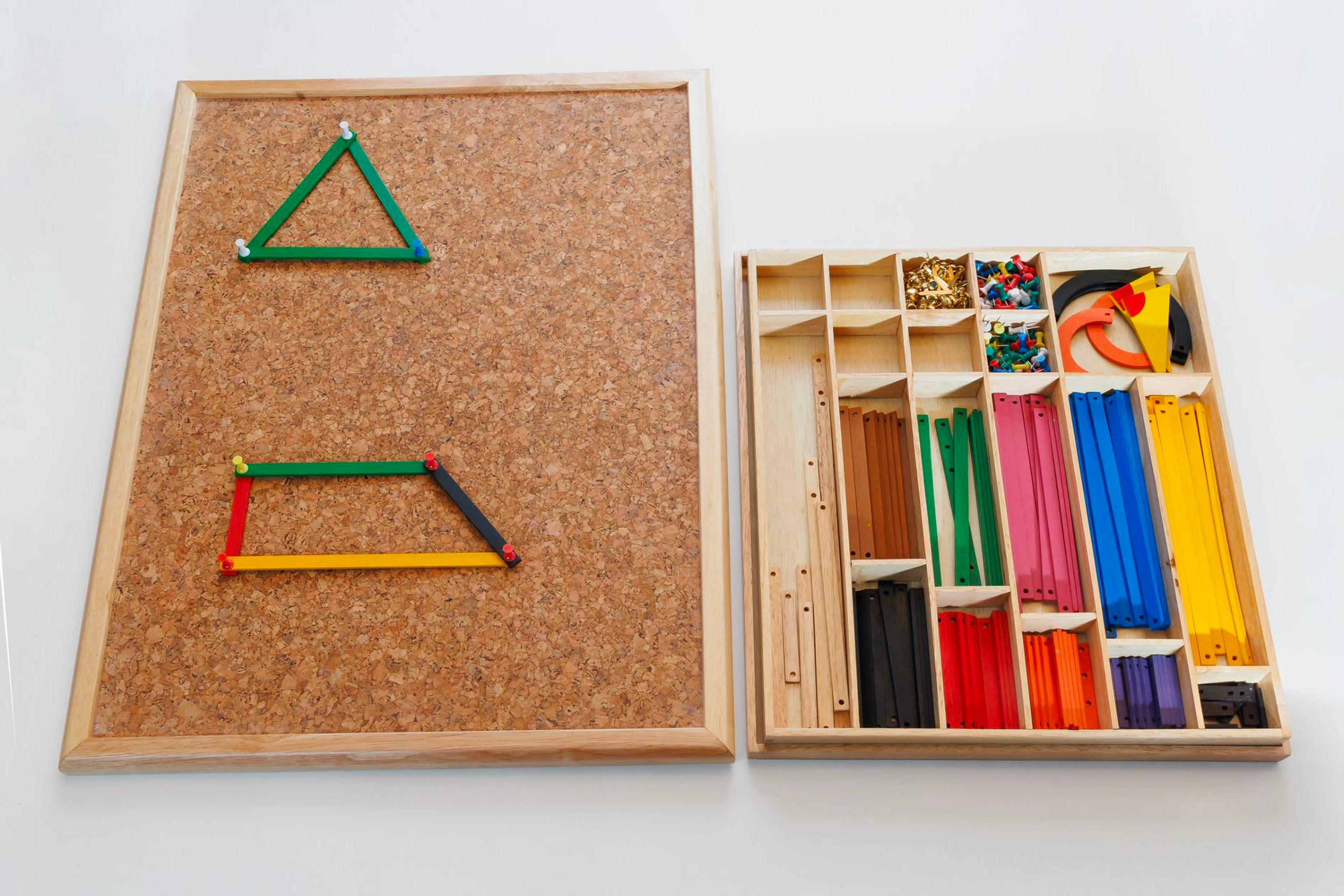Geometric Sticks
A detailed guide to understanding the Geometric Box of Sticks material and how it is used within the Lower Elementary curriculum
How does it work?
The Geometric Sticks introduce your child to the building blocks of geometry. Using this material, they will construct, label, and define different types of lines, angles, and plane geometric shapes. In doing so, they internalize these concepts and develop the ability to mentally manipulate area and shape.
Your Guidepost kit contains 10 sets of color-coded wooden sticks ranging from 2-20 cm, a plastic measuring angle, tacks, brass fasteners, a compartmentalized box with lid, and a wooden-framed cork board.
Prerequisite Skills - Working with the Geometric Sticks is intended for students around 6 years old who have developed fluency with:
- A grasp of basic concepts in geometry like point, ray, and line
- Vocabulary of basic geometric shapes
sample lesson.
Start by watching this sample lesson from our Guidepost Homeschool platform that will familiarize you to the Geometric Stick materials and their use.
If you are already subscribed to Guidepost Homeschool, scroll down to see all the corresponding lessons where the Geometric Sticks are used in our curriculum. To unlock more than 2,000+ lessons subscribe to Guidepost Homeschool today.
how to set up.
Setup - The Geometric Sticks set consists of four materials. These may come individually packaged within your kit:
- A series of color-coded sticks, curves, and a plastic measuring angle
- Brass fasteners
- A wooden box and lid to store materials
- Working board for geometric sticks
Place the colored sticks back into their respective compartments after you unwrap them. Fill a couple of the smaller compartments with the colored tacks and brass fasteners.
Additional materials to have handy:
- Pencil and paper for tracing and measuring
- A T-square or book
- Paper for labels
- Highlighters, markers, colored pencils, glitter glue or gel pens of your choice
- White glue, scotch or masking tape
- Ruler, scissors, protractor
- Compass or circular object like a cup or plate for tracing
- Yarn or string
- Craft supplies: straws, pasta and/or popsicle sticks
For Guidepost Homeschool subscribers
If you are already subscribed to Guidepost Homeschool, start in the order below to navigate to the corresponding lesson plans using the Geometric Sticks in our Altitude learning platform.
Wondering about supplies used in particular lessons? Detailed materials lists can be found at the beginning of each lesson in Guidepost’s Altitude system, as well as on the materials cards at the beginning of each unit.
- Corresponding Altitude lessons
Lessons (Altitude Cards) where the Geometric Sticks are used
Lines (Ages 6-9)
- Introduction to Lines
- Parts of a Line
- Relationship of a Line to a Plane
- Parallel, Convergent, and Divergent Lines
- Intersecting Lines
- Perpendicular Bisector Introduction
Polygons (Ages 6-12)
- What is a Polygon?
- Curvy Shapes
- What are Regular Polygons?
- Polygon Parts!
- Parts of a Triangle
- Types of Triangles According to Sides
- Types of Triangles According to Angles
- Parts of a Right Triangle
- Kinds of Quadrilaterals Part 1
- Kinds of Quadrilaterals Part 2
- Types and Parts of a Trapezoid
- Parts of a Kite and Rhombus
Angles (Ages 8-12)
- Types of Angles Part 1
- Types of Angles Part 2
- Parts of Angles
- Theorem of Angles
- Relationship Between Two Angles
- Combination of Angles
- Angles Formed by a Transversal
Circle (Ages 8-12)
- Parts of a Circle
- Surface of a Circle
- What is Guidepost Homeschool?
